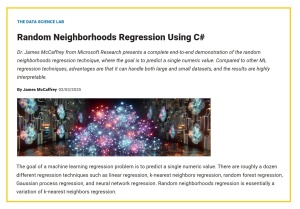Kaiming He at MIT sees AI breaking down walls between scientific disciplines, creating a common language for progress and collaboration. From AlphaFold to ChatGPT, AI tools are propelling advancements in diverse fields like protein structure prediction and natural language processing.
LLM applications require intentional temperature settings to control randomness. Temperature values impact the model's outputs, making them more random or focused. Softmax function transforms raw scores into a clean probability distribution for accurate predictions.
DeepSeek's R1 model praised for performance & cost, sparking potential change in LLM landscape. Understanding LLM benchmarks key to cutting through hype & creating specific use case benchmarks.
MIT researchers have found flaws in traditional spatial prediction validation methods, leading to inaccurate forecasts. They developed a new technique that outperformed common methods in predicting weather and air quality, offering more reliable evaluations for various applications.
Audio Processing relies on statistical models like Gaussian Mixture Model (GMM) to classify and simulate background noise in different environments, aiding in developing DSP solutions for interference cancellation and speech enhancement. GMM distributions with varying probabilities accurately represent different noise sources, crucial for practical audio systems.
Experts like Dr. Tom McClelland and Prof. Virginia Dignum discuss the ethical implications of AI consciousness in a recent open letter. The debate centers on the challenge of determining if AI can truly be conscious or if it is just mimicking consciousness.
Data science teams face challenges in transitioning models to production, but a multi-account ML platform addresses these issues. Roles like lead data scientist, data scientists, ML engineers, and governance officers work together to streamline the ML lifecycle, ensuring security and efficiency.
A/B tests compare Treatment A and Treatment B for campaigns to determine which drives more revenue per buyer. Marketers analyze purchase rates and average order amounts to optimize campaigns efficiently.
AI-designed proteins neutralize deadly snake venom faster, cheaper, and more effectively than traditional antivenoms. This breakthrough offers hope for affordable, accessible treatment to save millions of lives and livelihoods in rural communities worldwide.
Diffusion Models explained with illustrations, focusing on how they learn and generate data. Example using glyffuser to generate Chinese glyphs from English definitions.
New EPA administrator Lee Zeldin's pillars prioritize auto industry support, omitting climate crisis. Unusual focus on AI as key agency priority raises eyebrows.
Researchers at Los Alamos repurposed Meta’s Wav2Vec-2.0 AI model to analyze seismic signals from Hawaii’s Kīlauea volcano. The AI can track fault movements in real time, a crucial step towards understanding earthquake behavior.
Sara Beery applies computer vision and machine learning to monitor salmon migration, critical for ecosystem health and cultural significance in the Pacific Northwest. Accurate salmon counting essential for managing fisheries amid threats from human activity, habitat loss, and climate change.
Inefficient metric computation can increase training costs. TorchMetrics optimizes metric collection in PyTorch.
Article highlights random neighborhoods regression, an ensemble approach using multiple k-nearest neighbor systems with different subsets and k values to predict target values. The method's demo showcases model training and prediction accuracy, emphasizing the technique's versatility and potential in machine learning.















